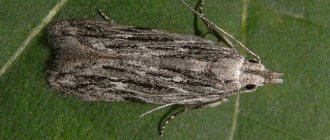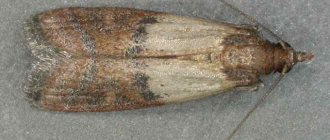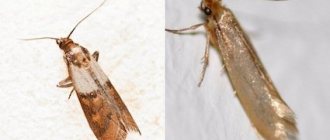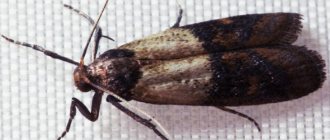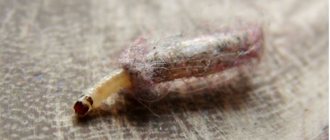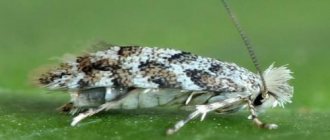Features of the insect
Getting rid of fruit moths is difficult - this voracious insect is not so easy to detect at the very beginning. The fact is that adults are already flying around the kitchen, but they don’t eat anything at all. Their main goal is to find a secluded place and lay eggs there, from which moth larvae will hatch in a few days. It is they who turn delicious dried fruits into real dust.
You can recognize fruit moths by the characteristic stripes on the tips of their wings. It is small in size, only about 1 cm long. Look at what the fruit moth looks like in the photo, so that if it appears, you can identify the enemy by the appearance of the moth butterfly. The grown larvae can be seen with the naked eye; they do not look like small worms. They hatch from eggs hidden in a cocoon, as if made from a cobweb.
Fruit moths can appear not only in dried fruits. An excellent habitat for it are bags of cereals or flour. Moth larvae prefer to eat sweet fruits, but the butterfly can lay eggs in a dry place next to them, and the hatched larvae will crawl to the delicacy on their own.
Fortunately, they do not crawl long distances, so fruit moths can appear in an apartment only in one of the following ways:
- fly through the ventilation ducts and settle in the food cupboard;
- entering the house with a new batch of low-quality dried fruits;
- fly into an open window, especially in the evenings when the lights are on in the windows.
Therefore, it is quite possible to protect yourself from its appearance and it is much easier to do than getting rid of moths in dried fruits.
Signs of appearance and damage caused
Usually, the appearance of fruit moths can be noticed when the products can no longer be saved: during the period of intensive growth of the larvae. They are the ones who leave behind dense lumps of excrement, pieces of cobwebs, and gnaw passages in dried fruits or nuts. And in general, it’s hard not to notice white worms scurrying around in a bag or package.
The harm from fruit moths is actually colossal: after all, the insect does not limit itself in food preferences.
Having accidentally appeared in an apartment, it is capable of destroying any food: cereals, cookies, flour. If you store dried fruits together with other food products, you can probably run out of supplies.
External characteristics
If you have observed repeated appearances of butterflies over the course of three weeks, this is evidence that the infestation is quite serious and it is necessary to immediately take steps to eliminate the insects.
The winged moth is no longer capable of causing any harm, since their oral organ is reduced upon reaching sexual maturity. Parasites are their larvae, which, having powerful jaws, feed quite intensively and accumulate energy reserves so that upon reaching the adult stage they have the opportunity to reproduce.
Interesting fact! The absence of a proboscis is due to the fact that, upon reaching sexual maturity, the moth loses not only the ability to feed, but also to digest food. Therefore, they simply do not need this organ.
The caterpillar's head is brown. As a rule, infestation of dried fruits and vegetables with this type of moth will be indicated by small, neat nests and a thin cobweb around them. The larva will be inside the nest.
Appearance
The fruit moth goes through several stages of development. In everyday life, a moth is usually called a nondescript moth of a gray, brownish color. The size does not exceed 3 cm with open wings. Butterflies are active in the dark, but you can periodically notice moths fluttering during the day.
On a note!
Moth eggs are extremely small and almost impossible to notice with the naked eye. One female lays up to 100 pieces during the entire life cycle - 3-14 days under favorable conditions.
The larvae are white caterpillars or worms with a dark “muzzle”. The food inside is visible through the translucent covering of the body.
The moth larval phase ends with the formation of a cocoon, pupation. After 2-3 days, a moth appears. There are no significant differences in the appearance of females and males. The fruit moth is pictured below.
Lifestyle and reproduction
It is not difficult for fruit moths to get into an apartment: you can hardly notice its clutches in a package with the coveted dried fruits. In nature, it lives in the tropics, so it definitely won’t fly in through a window or ventilation. But in large warehouses, where the assortment is represented by nuts, apples, and dried fruits, this is a frequent guest.
True, given the huge number of related species, some other species that flew through a window or escaped from neighbors through the ventilation system could easily settle in a bag of dried apples or nuts.
Fruit moths are nocturnal, prefer high humidity - at least 60%, and for unhindered reproduction they need a temperature of 28-30 ° C, then at least 3 populations of insects are hatched per year.
One fruit moth butterfly can lay up to 350 eggs, from which white larvae hatch. Quite often they can be found in dried apricots or figs, but home-dried apples are also susceptible to this scourge.
Do food moths eat clothes and what kind?
The food moth is capable of destroying huge human food reserves , but this insect does not touch clothing . Such a butterfly is not dangerous for the wardrobe. However, you should not relax, because clothes moths can also live together with food moths . This moth is visually very similar to a food butterfly.
Often, in the struggle to remove food moths, people do not pay attention to clothes moths. Food moths also do not lay larvae in clothing, and the larvae do not harm fur, sheepskin, cotton and other types of fabric.
Food moths do not harm human clothing at all
Actions to take when a pest is first detected
Moths do not appear on their own. Most often, you yourself bring it into your home with food; less often, an adult may fly into a window or an open door. As a rule, contamination occurs as a result of violation of the storage conditions of the product, and this can happen both in the factory warehouse and in the store itself.
- If you purchase dried fruits in original packaging, then carefully check its integrity before purchasing. If you find even one minor hole, set the product aside.
Advice! The easiest way to check the factory container for damage is as follows: squeeze it in your hands, and if it begins to gradually deflate, it means the seal is broken.
We talked in detail about moths in cereals and the fight against them in a separate article: How to get rid of cereal moths?
Advice! Do not purchase dried fruits at bargain prices, as quite often the seller tries to sell the contaminated goods at a discount.
Preventive measures
We told you how to deal with pest infestation in the pantry if they have already infested. But to prevent this from happening, it is easier to prevent their occurrence by fulfilling simple requirements:
- To prevent an adult insect (2.5 cm) from entering the room, you need to protect all ventilation windows with fine mesh grilles;
- do not buy goods by weight in the markets; vacuum packaging does not give the insect a chance of survival;
- have a separate storage container for each type of dried fruit;
- constantly check the stock status;
- if possible, immediately after purchase, dry the fruits in the oven with the door open;
- do not make large purchases of dried fruits; small stocks can be stored in the refrigerator;
- The pantry must be frequently ventilated and kept clean and tidy.
Advice. To repel moths, you can use folk remedies: tobacco, dried lavender, and from ordinary means - fumigators or traps.
The food that comes to our table brings us energy - to live and work, vitamins and microelements - to be healthy and beautiful, pleasure - to remain satisfied with our fate. But food with a wormhole can destroy all this forever, ruin it. Someone said, cleanliness is the key to health, so take care of this guarantee, and keep food supplies clean, be healthy.
Why are fruit moths harmful?
Fruit moths are not dangerous for humans; they do not bite or attack. But the insect still causes harm. As mentioned above, the insect lays larvae that eat food.
Fruit moth eggs can be seen in the kitchen, pantry, warehouses and other places where food is stored.
The larvae are attracted to fructose, which perfectly saturates them and allows them to grow, and is also quickly absorbed. For this reason, most often the larvae can be seen in fruits, dried fruits, nuts, etc.
Although the adults do not feed on human food, they reproduce and lay eggs and are therefore harmful.
What does this butterfly eat?
Fruit striped moths can lay eggs in any food; the larvae can feed on nuts, seeds, and cereals. Since dried fruits contain sugar, that is, a substance that is most easily digested, she prefers bags and jars with dried fruits for her offspring as the main place for nursing. As soon as the larvae hatch, they immediately begin to eat dried fruits, gnawing holes in them. During the growth process, molting products - chitinous scales, toxic substances of vital activity, thereby clog dried fruits from the inside. Therefore, such dryings, after the appearance and detection of these parasites, are thrown away. Eating them is dangerous - you can get seriously poisoned.
Larvae or eggs of fruit moths may end up directly on the surface of the shelf and if other food products appear in this place, uncollected parasites can also infect them
That's why it's so important to get rid of them as soon as possible.
Dried fruits affected by moths should be destroyed immediately
Where do fruit moths come from in the house?
The easiest and most common way for fruit moths to enter an apartment is through food.
For example, you bought products in a store that contain moths, most often this happens in markets and open pavilions, but it happens that you encounter this insect in supermarkets.
You can also bring moths from your dacha. When harvesting, you need to make sure that there are no moths or their larvae in vegetables and fruits, as they will turn into butterflies and continue to multiply.
Moths can also get into the house through the ventilation system from neighbors or from the basement.
During the warm season, fruit moths can fly into a room through an open window or door.
Where does it come from?
Food moths can get into a person’s home in different ways. Pest larvae may already be in products purchased in stores, since storage conditions in warehouses do not always correspond to the norm. And this leads to the proliferation of the pest. In the absence of dried fruits, moths appear in cereals, flour, tea and nuts. The only things that don't appeal to her are spices and coffee.
Pupae of the pest may also initially be found in fruits that have been used for drying. And since they are subsequently stored in a dry, dark place, such conditions are ideal for further reproduction.
Moths can also fly in through an open window at night. As a result, she finds a favorable place and lays eggs.
Destruction of moths
Methods for killing moths
The moth is not distinguished by its quick reaction or strong flight abilities. It's easy to slam him. But there is no guarantee that this is the only or last butterfly in the room, so you should play it safe and use effective moth repellents in the apartment and in the kitchen in particular.
- Sticky tapes are hung around the kitchen, anti-moth tablets and special traps are used in cabinets.
- Among the folk remedies, herbs such as lavender, peppermint, chamomile, and geranium will help repel the pest. These plants repel moths with their scent. Orange peels and garlic are also excellent repellents.
- Ventilating the kitchen for 20 minutes every evening during cold periods reduces the activity of moths and creates unfavorable living conditions for them.
- In case of severe infestation of the premises, aerosols and moth sprays are used. Initially, they carry out cleaning to destroy the larvae, wipe down the cabinets, and hide the food in airtight containers. Disinsection is carried out. Use any insecticidal agent - Raptor, Raid, Antimol, Clean House, Dichlorvos. After 20 minutes, ventilate, carry out wet cleaning by adding baking soda and laundry soap to the water. An alkaline environment completely neutralizes the effect of the insecticide.
Not only does dry fruit attract moths into the house, any food supplies can become contaminated if the insect gains access to them. Preventative measures are extremely important to prevent infection.
Fighting methods
There are several ways to get rid of moths in dried fruits and other contaminated products. The main control methods are aimed at destroying the larvae, but butterflies should not be left without attention.
If there is a moth in dried fruit, its presence can be detected by the presence of white caterpillars of different sizes, grains from the chewed mass, and cobwebs. At the same time, small moths may periodically flutter around the kitchen. How to get rid of moths in dried fruit depends on the degree of infestation.
- Sort through the dried fruits, place on a baking sheet, and roast in the oven for a few minutes. In this way, eggs are destroyed, larvae, and butterflies are removed manually.
- After a thorough inspection, sort out the dried fruits and place them in places with bright sunlight. In this way, unfavorable conditions are created for the development of fruit pest larvae.
- In case of severe infection, it is easier to throw the dried fruits along with the container outside into the trash can. If food was stored in a cloth bag, it can be washed in hot water to destroy pest eggs.
To get rid of fruit moths completely, it is necessary to exterminate the butterflies and create unfavorable conditions for laying eggs. To get rid of moths in the kitchen, cabinets where infected dried fruits were stored are treated with folk remedies for moths: wiped with water with the addition of table vinegar, ammonia, and lavender essential oil.
Important!
To prevent re-infestation of the fruit pest, it is necessary to review all food supplies. Fruit moths can lay eggs in cereals, flour, tea, dry medicinal herbs, nuts, and cocoa. Avoids only coffee and spices.
What to do if dried fruits are contaminated?
If there are moths in dried apples, you need to take urgent measures to save the remaining stocks. Otherwise, these insects can completely spoil all products. The situation can be corrected only if the damage is minor, otherwise the dried fruits should be thrown away.
Heat treatment
If adult flying individuals were found in the house, but their worms are not visible in the product, then heat treatment can be carried out for drying. To do this, you need to pour it onto a baking sheet and heat it in the oven at +60...700C for 40 minutes.
This pest does not tolerate low temperatures. Therefore, to save drying, you can place it in the freezer and leave it for a day.
Using improvised means
The means at hand will also help to cope with the problem. If there are moths in dried fruits, you need to dispose of spoiled products, and prepare special traps for adult moths. To do this, you will need to mix boric acid with flour in a ratio of 1: 3. Place the resulting mixture in separate containers and place them on the shelves of a cabinet or pantry.
Folk methods of struggle
In the fight against pests, you can also use folk remedies, especially since it is not always advisable to use chemicals in the kitchen next to food.
Effective ways to get rid of moths:
- Lavender. Place bunches of this herb on shelves where dried fruits are stored.
- Citrus. To repel the pest, chop the fruit peel and place it next to the drying container. It needs to be updated periodically.
- Vinegar. Dilute it with water at the rate of 1:3. Wipe the inside of the cabinets where the product is stored with the resulting composition.
Lavender
How to get rid of fruit moths
To completely get rid of the pest, you need to destroy not only the fluttering moths, but also the crawling larvae. And if an adult can simply be swatted with your hand or a special trap can be set for it, then some chemicals and folk methods are used to effectively fight the offspring.
Traditional methods
Infection of dried fruits and other bulk products is determined by the presence of white worms, cobwebs and grains from the chewed mass. If the degree of infestation is low, the dried fruit is sorted out and fried in the oven for several minutes.
If there is a large contamination, dried fruits are unfit for consumption and are thrown away along with the paper containers. If a canvas bag was used for storage, it can be washed at a water temperature above +50°C. After disposal of products, solid containers are washed with a solution of vinegar essence.
Vinegar and ammonia
The shelves of the kitchen cabinet where the moth offspring were found are thoroughly washed with the addition of vinegar or ammonia. You can dry them with hot air, armed with a hair dryer and setting the regulator to full power. Do not forget to warm up all the cracks and joints, because there may also be eggs or larvae there.
Plants
It is known that moths cannot tolerate the smells of lavender, geranium, mint, citrus fruits, bay leaves, and garlic. If the listed repellents are placed on the shelves, females will not be able to lay eggs, which means the products will be protected from voracious insect larvae.
Another popular method is to use salt to fight moths. It is poured into various containers and placed near the stored products. Salt absorbs moisture, creating a dry microclimate. Such conditions are unsuitable for the existence of moths. In addition, salt prevents the formation of mold and ensures better preservation of dried fruits.
Thermal impact
The larvae are also exposed to heat and cold using an oven, dryer and freezer.
Industrial products
Removing moths from the kitchen is complicated by the fact that insecticides cannot be used here. Otherwise, the chemicals will get into the food and cause poisoning to family members. Therefore, aerosols, sprays and other moth control products that can be used in other rooms are prohibited in the kitchen. What remains are sticky tapes and special traps that are used to catch adult individuals.
The principle of the traps is simple: the pheromone component attracts insects, and the adhesive layer reliably holds the stuck moths. Such devices are harmless to humans and pets.
Prevention methods
Preserving dried fruits from moths at home is quite difficult, but if you wish, you can avoid troubles.
- Store dried fruits in places with bright sunlight or in a room with low temperatures.
- Periodically sort through the supplies and heat in the oven for a few minutes.
- Wipe cabinets with water and vinegar or place repellents. The moth is afraid of a pungent odor, but with constant presence it gets used to it, so protection should be alternated.
- Place special traps, tablets, cassettes against moths and their larvae next to dried fruits.
You need to begin active actions immediately after discovering at least one moth or caterpillar. Knowing what moths are afraid of, you can quickly eliminate the problem. Otherwise, all food supplies will be contaminated, which will then have to be thrown away. Due attention should be paid to proper storage of dried fruits.
Frozen storage
With the advent of spacious freezers in our lives, it has become common to keep crops frozen
When frozen, dried fruits lose some of their nutrients, but if there is no other option other than freezing, it is important to know how to store dried fruits in the freezer
No special preparation is required when storing. Dried fruits are placed in small batches in storage containers (food containers or zip-lock bags) and frozen.
Dried fruits can be stored in this way for several years, provided that they are not defrosted and the temperature in the freezer is at -20°C or lower.
Defrosting should only take place at room temperature. It is best to first place the products from the freezer on the top shelf of the refrigerator, and after a few hours at room temperature. You should not defrost the preparations in hot water or the microwave; the fruits will become tasteless and too soft.
Dried fruit protection
You can prevent the appearance of fruit moths if you take care in advance about the proper storage of food. To do this, it is necessary to prevent a sexually mature individual from laying eggs.
How to save dried fruits from moths?
Favorable conditions for moth reproduction are temperature +250C degrees and humidity within 50%. Infection can be eliminated if you prepare food for storage, select containers and determine the location.
Preparation for storage
To prevent moths from infesting dried fruits, you must first check their quality. To do this, you need to sort through them and remove everything that causes suspicion. Then, as a preventive measure against mold and insects, you should additionally dry them in the oven at a temperature of +60-800C for half an hour.
Attention! The shelf life of dried fruits is 12 months. After this period they should be disposed of.
Selection of containers
To store dried fruits, you must use hermetically sealed glass containers. After pouring the product into them, you need to put a paper napkin on top, which will absorb moisture.
Determining the storage location
Dried fruits must be stored in a dark, dry place where sunlight does not penetrate. The best option may be a shelf in a pantry or closet.
Protective measures
To preserve dried fruits and protect them from moths, it is necessary to check them regularly throughout the storage period. If stickiness appears, dry it in the oven. Also, to prevent high humidity in the storage area, you should place containers with salt nearby, which will absorb excess moisture.
How to store your own dried fruits
Experienced housewives, who have never thrown away spoiled fruits, try to prepare them on their own and preserve them for a long time. To ensure that they are stored properly and for a long time, we recommend taking certain measures.
Store different fruits and nuts in separate containers
Drying rules and preparation for storage:
- To ensure that fruits dry evenly, you need to cut them into equal pieces or slices.
- During the drying process, the finished dried fruits are put in a cooler place, the remaining chopped fruits are turned over and tossed, bringing them to the required drying.
- Select storage containers that are hermetically sealed: dense but breathable bags, containers with lids or glass jars.
- Before packaging, the containers must be sterilized; containers, if they are not heat-resistant, are disposable.
- Fill them with dried fruits to 2/3 of the height, leaving room for air.
- Containers are stored at a temperature of about +10 degrees.
During the entire storage period, it is necessary to check the condition of the product, taking into account humidity and the presence of pests. The main insects that attack dried fruit are fruit moths and aphids.
How to prevent fruit moths from appearing in the house?
It is always easier to prevent the appearance of an insect in the house than to get rid of it.
There are simple measures that can help significantly reduce the likelihood of fruit moths.
There should be nets on the windows; they will protect you not only from moths, but also from many other types of insects. The ventilation holes should also be covered with a grille, and the smaller the cells, the better.
As soon as you see a fruit moth in the house, you need to kill it immediately so that the insect does not have time to lay eggs and reproduce.
It is better to store food not in a bag, but in special sealed containers. They will not only protect food from the appearance of larvae, but also maintain its freshness.
Food supplies should be checked periodically and any contaminated items should be thrown away.
In warm weather, once a month it will be useful to wipe the inside of all cabinets with a solution of vinegar essence.
Fruit moths are a pest that cause you to throw away food. To protect your home and food from insects, follow simple precautions and, if necessary, apply the tips we described. And then your house will be clean, and all food supplies will be intact.
Popular questions
Housewives often ask the following questions about fruit moths::
- Can you get poisoned if you eat dried fruits infected with moths? By the time the larva becomes an adult, it will have time to change its skin several times, and through its vital activity it will contaminate food. During this time, a lot of feces and old insect skin will accumulate in the dried fruit. If you eat a lot of such foods, food poisoning can occur with serious intoxication of the body.
- Will freezing help? It is not advisable to put food in the refrigerator, since under the influence of low temperatures the larvae of fruit moths simply fall asleep. If you return them to their familiar environment, they calmly come to life and begin their activities. Eggs and larvae die only at high temperatures.
- Are moths afraid of washing powder? Neither ordinary soap nor washing powder are harmful to fruit moths. It can even live in washing powder packets. She is only afraid of the vinegar solution. After treating with this product, the containers can be washed with a solution of laundry soap to remove the specific smell of vinegar.
Fruit moths are a serious pest. If you don’t fight it, it can ruin not only drying, but also neighboring products. This especially happens with large stocks designed for long-term storage. Experienced housewives recommend not making large reserves. It is enough to purchase dried fruits in quantities for 2 weeks.
If moths or larvae appear, immediate measures must be taken to eliminate them. There are many different ways to do this.
It is also important to adhere to preventive measures so that later you do not have to put a lot of effort into exterminating pests.
Moths - how to prevent them from appearing in the house?
To avoid the proliferation of moths and their spoilage of products, you should resort to the following measures.
- Do not leave food in free spaces, try to clean up food after yourself, tightly cover bottles and jars where food is stored. If all this is sealed, then the insects themselves will disappear from the kitchen, even if they were inadvertently brought in from somewhere else.
- The scented geranium is a plant so unloved at the level of the insect kingdom. It has a characteristic pungent odor; geranium repels most known insects. In those houses where it is common, moths are rarely found. Exactly the same effect can be produced by breeding lemons that are intolerant to moths.
- Periodically you need to inspect the cabinets for suspicious things. If insects are found in certain packages, they must be disposed of immediately.
- Carry out routine cleaning of the entire interior of the kitchen, and if that doesn’t work, then the cabinets where the spaces that are most vulnerable to insect penetration are stored (containers, chests, drawers, etc.).
All the information presented above will allow you to fully formulate your understanding of fruit moths. This is an extremely unpleasant insect that can be easily gotten rid of if you follow a number of simple procedures that were presented above.
